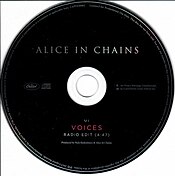This article needs additional citations for verification. (October 2023) |
In music, a single is a type of release of a song recording of fewer tracks than an album or LP record,[1] typically one or two tracks. A single can be released for sale to the public in a variety of physical or digital formats. Singles may be standalone tracks or connected to an artist's album, and in the latter case would often have at least one single release before the album itself, called lead singles.[2]
The single was defined in the mid-20th century with the 45 (named after its speed in revolutions per minute), a type of 7-inch sized vinyl record containing an A-side and a B-side, i.e. one song on each side.[3] The single format was highly influential in pop music and the early days of rock and roll, and it was the format used for jukeboxes and preferred by younger populations in the 1950s and 1960s.[4][5]
Singles in digital form became very popular in the 2000s.[6] Distinctions for what makes a "single" have become more tenuous since: the biggest digital music distributor, the iTunes Store, only accepts as singles releases with three tracks or fewer that are less than ten minutes each (with longer releases being classified as "EPs" or "albums").[1] However, releases which do not fit these criteria have been promoted as singles by artists and labels elsewhere, such as on the Bandcamp storefront.
Nowadays physically-released music is mainly bought in the form of full-length albums instead of singles.[7][8] The most common physical formats of singles had been the 7" (45) vinyl records and the CD single, but singles have also been released on other formats such as 12" vinyl records, 10" shellac records, cassette single, and mini CD.
- ^ a b "Single and EP Definitions on iTunes". Emubands.com. 22 April 2013. Retrieved 24 June 2016.
- ^ Leight, Elias (7 May 2018). "Why Your Favorite Artist Is Releasing More Singles Than Ever". Rolling Stone. Retrieved 3 May 2024.
- ^ "Beatles Singles Discography". University of Delaware. Retrieved 29 March 2019.
- ^ Pollack, Andrew (1 April 1990). "Recording Enters a New Era, And You Can't Find It on LP". The New York Times. ISSN 0362-4331. Retrieved 6 May 2024.
- ^ Browne, David (15 March 2019). "How the 45 RPM Single Changed Music Forever". Rolling Stone. Retrieved 6 May 2024.
- ^ Covert, Adrian (25 April 2013). "A decade of iTunes singles killed the music industry". CNNMoney. Retrieved 6 May 2024.
- ^ "The single returns from the dead, digitally". NBC News. 10 May 2007. Retrieved 3 May 2024.
- ^ "Attempting To Explain The UK Official Chart Without Losing My Mind". Picky Bastards. 26 January 2022. Retrieved 3 May 2024.

